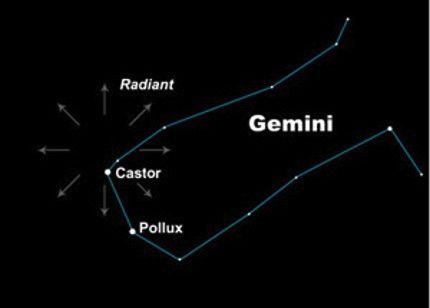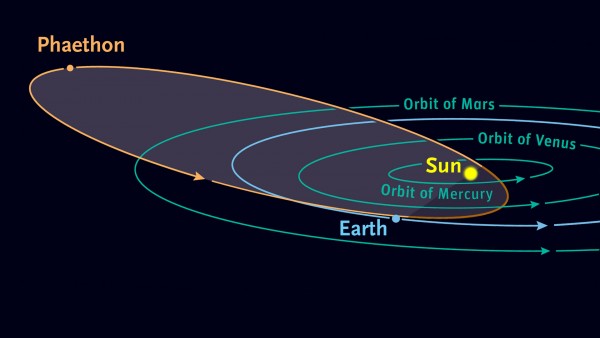Tonight – December 13, 2016 – is likely the peak night of the 2016 Geminid meteor shower, though under the drenching light of the full supermoon that we in the Northern Hemisphere call the Long Night Moon or Cold Moon. In the Southern Hemisphere, the name Short Night Moon works better, but doesn’t make the list of full moon names. The moon turns full on December 14 at 0:05 UTC (or at U.S. time zones: on December 13 at 7:05 p.m. EST, 6:05 p.m. CST, 5:05 p.m. MST and 4:05 p.m.). So get ready for some fist-shaking at the moon tonight! And, if you still want to watch meteors, go to a location as free from city lights as you can from late Tuesday evening until dawn Wednesday. You might see some bright Geminids flying in the moonlight! Follow the links below to learn more about 2016’s Geminid meteor shower.
When is the best time to watch the Geminids in 2016?
What’s the best way to watch a meteor shower?
How many meteors can I expect to see in 2015?
Where is the radiant point for the Geminid meteor shower?
What is the origin of the Geminid meteor shower?
Expecting clouds? Watch December’s supermoon online with Virtual Telescope Project in Italy, December 13, beginning at 16:00 UTC; translate to your time zone. Astronomer Gianluca Masi said the presentation will likely include some shots of Rome’s monumental landscape, as the moon is rising.

When is the best time to watch the Geminids in 2016? As a general rule, the Geminid meteor shower intensifies after midnight and produces the greatest number of meteors for a few hours, centered around 2 a.m. Around that time, watch for the dazzling planet Jupiter to be rising in your eastern sky. This year, however, the full moon will not allow for any dark sky for the peak night of the Geminid meteor shower (December 13-14).
What’s the best way to watch a meteor shower? You need to get away from city lights and find a wide open view of the sky. City, state and national parks are good, and you might be able to camp and make a night of it. Enjoy the comfort of a reclining lawn chair – the warmth of a sleeping bag – a thermos with a hot drink – a snack – and possibly star maps with a red flashlight, if you want them (you won’t need them to enjoy the meteors).
Give your eyes at least 20 minutes time to adapt to the dark. Often, meteors come in spurts and are interspersed by lulls. So give yourself at least an hour to watch the Geminids.
You don’t need special equipment – only a dark, open sky. Simply look upward and enjoy the company of family and friends.
How many meteors can I expect to see in 2016? The Geminids are considered one of the best meteor showers for the year in the Northern Hemisphere. In a year with no moon, they reliably offer 50-120 or more meteors per hour at their peak. In 2016, the full moon is sure to diminish the numbers but we expect some bright Geminids to overcome the moonlit glare. How many is hard to say.
You can also see this shower from the tropical and subtropical regions in the Southern Hemisphere. Farther south, the radiant of the Geminid meteor shower never gets very high in the sky, so the shower is not as rich at southern temperate latitudes. Sigh.

Where is the radiant point for the Geminid meteor shower? This meteor shower gets its name from the constellation Gemini the Twins. If you trace the paths of all the Geminid meteors backward, they appear to radiate from a certain spot in front of Gemini. This point is called the meteor shower radiant point. The Geminids radiant is located near the bright star Castor.
Just remember, you don’t have to find the meteor shower radiant to see the Geminid meteors. The meteors radiate from that point, but they then shoot all over the sky. The radiant for the shower is rather low in the east at early evening, meaning the meteors will be few and far between at that time. The radiant climbs upward as evening deepens into late night, and reaches its high point for the night around 2 a.m. local time. That’s why greatest number of meteors usually fall after midnight, for a few to several hours, centered on or near 2 a.m.

What is the origin of the Geminid meteor shower? Most meteor showers take place when our planet Earth crosses the orbital path of a comet. The comet debris plunges into Earth’s upper atmosphere, and the vaporizing particles fill the night with meteors. But the Geminid meteor shower appears to be an oddity. The shower’s parent body appears to be a near-Earth asteroid, rather than a comet. Astronomers have named this object 3200 Phaethon.
Bottom line: The forecast calls for the night of December 13-14 as the peak night of the 2016 Geminid meteor shower, though under the glaring light of the Long Night or Cold Moon. Geminid meteors tend to be bright, so you might see a few Geminds streaking the sky, despite the moonlight. Have fun!











